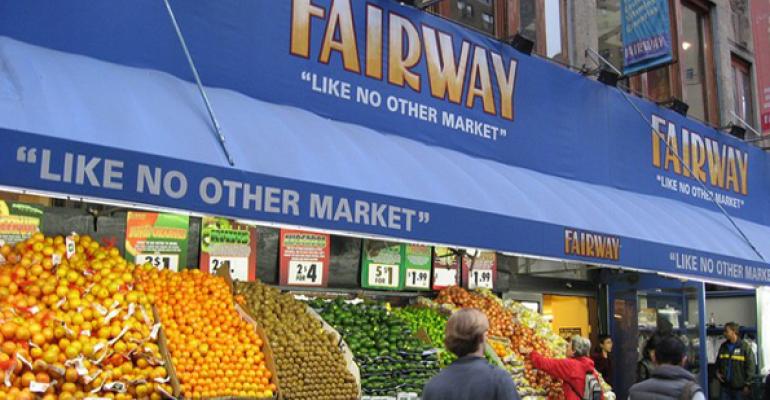The crowded national grocery market is about to welcome another player—New York-based supermarket operator Fairway Group Holdings Corp. On Apr. 17, the company conducted an IPO, selling more than 13.6 million shares at $13 apiece, with the stated goal of expanding to potentially 300 stores nationwide.
Given Fairway’s stellar performance in its New York metro home base, the IPO turned out to be the fourth best-performing public offering year-to-date, according to SeekingAlpha.com. As of Monday morning, the value of Fairway’s stock rose 33 percent, to $18.61 per share. Yet the question remains whether Fairway can replicate its success formula, based on very dense, urban demographics, in 300 additional locations.
That kind of growth might be at best challenging, according to David J. Livingston, of supermarket consulting firm DJL Research.
“That type of talk is usually reserved for large, profitable and debt free retailers,” Livingston says. “I think that was just salesmanship for the press release.”
“I think Fairway is learning as you get further away from your home base, like their store in Stamford, Conn., volumes start to drop off sharply. It’s very difficult to maintain the momentum as a company grows.”
Great model
Supermarket consultants had nothing but praise for Fairway’s operating formula, namely selling high-quality perishable foods at competitive prices. The company’s IPO filing states that during fiscal 2012, its stores delivered net sales of $1,859 per sq. ft., making them one of the most productive in the industry, according to Neil Stern, senior partner with McMillan Doolittle LLP, a Chicago-based retail consulting firm. In contrast, Whole Foods’ newer stores (opened in the last year and a half) delivered average sales of $764 per sq. ft. as of first quarter 2013.
But part of the reason Fairway has been able to achieve such high sales volume is that its stores are located in the densest market in the country, he notes. As of April, the chain operated 12 locations, in New York, New Jersey and Connecticut. Four of the stores are located in Manhattan, with a fifth scheduled to open this summer. There are also single Fairway stores in Queens and Brooklyn, and locations in Paramus and Woodland Park, N.J., Pelham Manor and Westbury, N.Y. and Stamford, Conn.
However, Fairway has indicated that its average net sales per store and per sq. ft. have declined as it opens new stores.
“It’s a very unique chain. Their business proposition is that their [sales] volume is much higher than that of any conventional supermarket,” Stern says. At the same time, “that means that they need specific types of locations that have enough density to support that proposition. As you leave the New York City metro area, that becomes more difficult to find.”
Fairway’s IPO filing indicates that it plans to open two new stores in fiscal 2014, followed by three to four stores a year in the New York region before expanding onto the national stage. That strategy makes sense for a regional chain as expanding too quickly is one of the most common mistakes retailers tend to make, according to Mark Heckman, of Bradenton, Fla.-based Mark Heckman Consulting Group. He expects that Fairway’s next step would be to start opening stores in other major metro centers along the Eastern seaboard, including Boston, Baltimore, Philadelphia and Washington, D.C.
The challenge, according to Stern, is that those markets’ population density falls short of New York City’s, and that challenge is only likely to grow more pronounced as Fairway will attempt to break into other parts of the country.
“They don’t replicate New York City because nothing does, but they look and feel relatively similar,” Stern says of cities like Boston and Philadelphia. “For this type of chain, whenever somebody says we can open 300 of these stores, you are more concerned about the 13th and 14th unit than whether they will have 300 or not.”
Since 2009, Fairway has opened eight new stores. The company claims that its urban format stores—which average 40,000 sq. ft. in size and cost approximately $16 million to open, deliver a return on investment within about two years’ time. Its suburban stores, measuring 60,000 sq. ft. and costing approximately $15 million each, deliver a return on investment in approximately three and a half years. Fairway leases its locations.
Real estate angle
An additional challenge for Fairway as it tries to move into new cities might be finding appropriate spaces, according to both Stern and Heckman. The chain has proved creative in solving a similar problem in New York City—its store in Brooklyn is located in a former 19th century coffee warehouse, while in Queens it took over a gutted old Waldbaum’s.
As building new stores from the ground-up in urban centers tends to be quite expensive, Fairway will likely continue rehabbing existing locations as it expands, Heckman says. That strategy would have the added advantage of allowing the company to apply for any existing tax abatements and urban renewal financing packages, he adds, especially in the Northeast.
Ultimately, however, according to Livingston, “Fairway will add a few stores, mostly to adjacent trade areas near their existing stores. I would expect slow methodical growth until they can become profitable and their debt is reduced.”
Fairway reported a net loss of $11.9 million for fiscal 2012. It also carries $274.3 million in debt.

